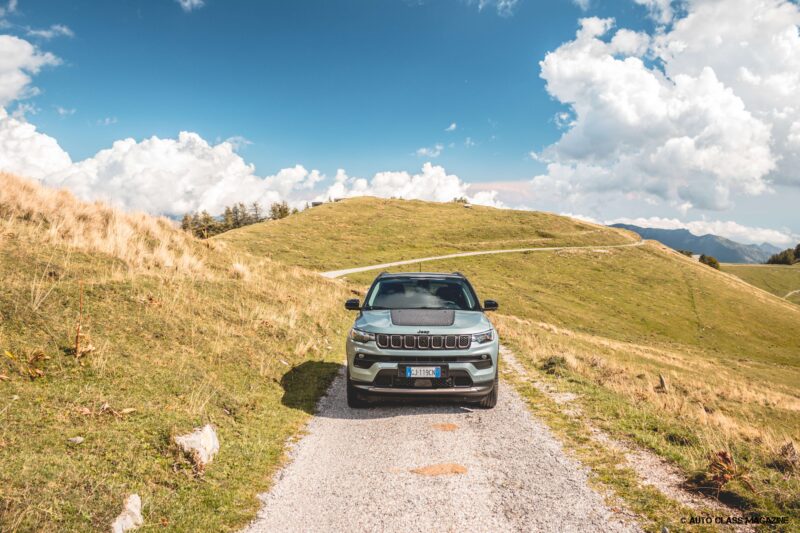
Jeep Compass | Test Drive
Words Matteo Lavazza / Photos Gian Romero
The second generation Jeep Compass – introduced in 2017 – has enjoyed a profound stylistic update that with the consequent restyling dated 2021 has further refined the American crossover, now able to be defined as an entity on its own and no longer a reduced scale version of the Grand Cherokee. In the increasingly populated segment it sits in, where a car must bring into play qualities suitable for everyday coexistence and weekend commutes, the Compass is one of the reference models in terms of variety of engines at disposal. In addition to the diesel engine we have in fact the possibility to choose it with two different types of petrol hybrids: the 190 or 240 horsepower rechargeable PHEV, or the Mild-Hybrid of our test, equipped with a 1.5 turbocharged petrol combined with a small electric motor for a total power of 130 horses.


The differences in appearance are small, almost non-existent. You gotta spot the e-Torque badge on the tailgate and the lack of the charging door, but dynamically the 4-cylinder of the e-Hybrid version does not make you regret the power less compared to the other versions. The batteries are also so small that they have been placed under the tunnel, so as not to affect the balance of the car and not even the rear load capacity, which has remained unchanged. With about 15 kW of electric power (about 20 hp) and a low weight of around a ton and a half – 1,575 kg – we then have a nice double clutch 7-speed gearbox, but in our case only the front wheel drive.

The unit of our test is a specific version called Upland and follows the ecological discourse using recycled materials for the seats, doors and dashboard, with a dedicated paint called Matter Azur and black details that recall the large imprint applied on the engine hood. Eco-friendly cockpit therefore, but which does not give up the important hi-tech package shared with the rest of the list, including the specific submenus you get in all hybrid engines, an excellent satellite navigator and complete connectivity with any mobile device via the 10.1″ central display . The steering wheel is very nice and comfortable, through which it is possible to recall and set various ADAS, including level 2 semi-autonomous driving and adaptive cruise control, while the active lane maintenance can be completely turned off courtesy of a physical button located in the central portion of the dashboard. In front of the driver’s eyes, we find the second digital display – 10.25″ – which includes the multifunction instrument panel and allows to keep everything within easy reach.






The Upland has 18-inch glossy black alloy wheels that in perfect Jeep style are not afraid of dust and mud. In this regard, although we’re dealing with a front wheel drive, the ground clearance and the attack angles of the Compass make possible to tackle even rough terrain, provided that all-wheel drive is not necessary. The logical strength of this new hybrid compared to the solid and valid diesel is silence, especially when the car is stationary, just like when the small electric motor comes into play and allows you to move even if for short distances, between 30 and 40 kph, as well as coasting in the ideal range between 80 and 90 per hour. An electrical system that facilitates starting from standstill therefore, which limits the overall consumption of the Compass and which provides a torque of 240 Nm at around 1,500 rpm, a value that underlines how brilliant and extremely versatile this car is.




The Compass e-Hybrid is the entry level petrol (since diesel start at € 33,800) and has an attack price of € 36,200, which increases by at least € 3,000 or € 7,000, depending on the chosen spec. At € 43,000 you can put your hands on the T4 S, so it is time to think about the Plug-In Hybrid 4xe options, with prices starting at € 46,750 for the 190 horsepower and € 50,500 for the most powerful 240-hp. Regardless of the engine, every Compass succeeds well in the primary objective of keeping fuel consumption low, with an average declared at 5.6 liters per 100 km. Among the equipments that I recommend not to give up, there is undoubtedly the automatic gearbox, while the four-wheel drive can be neglected, just to reconfirm the fact that this Jeep will be at ease and able to adapt to any road condition the 80% of people will have to deal with.


JEEP COMPASS e-HYBRID UPLAND
Engine 4 cylinder Mild-Hybrid, 1.469 cc Power 130 hp Torque 240 Nm @ 1.500 rpm
Traction Front-Wheel-Drive Transmission Cambio7-Speed Automatic Gearbox Weight 1.575 kg
0-100 kph 10,3 sec Top Speed 192 kph Price from€39.450




